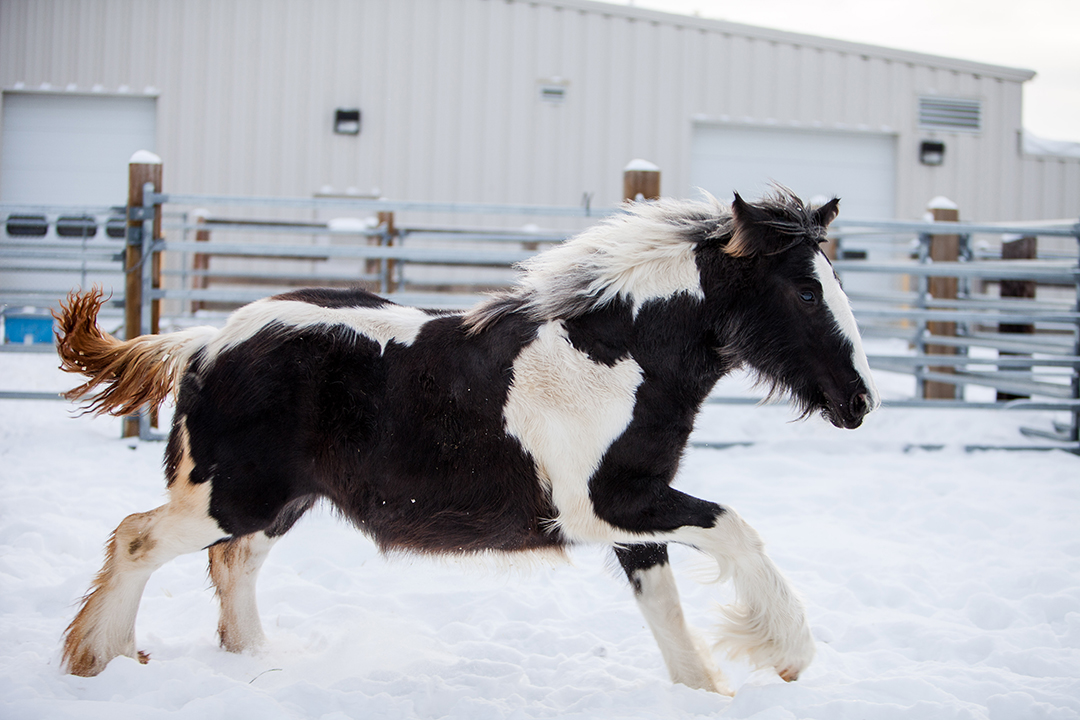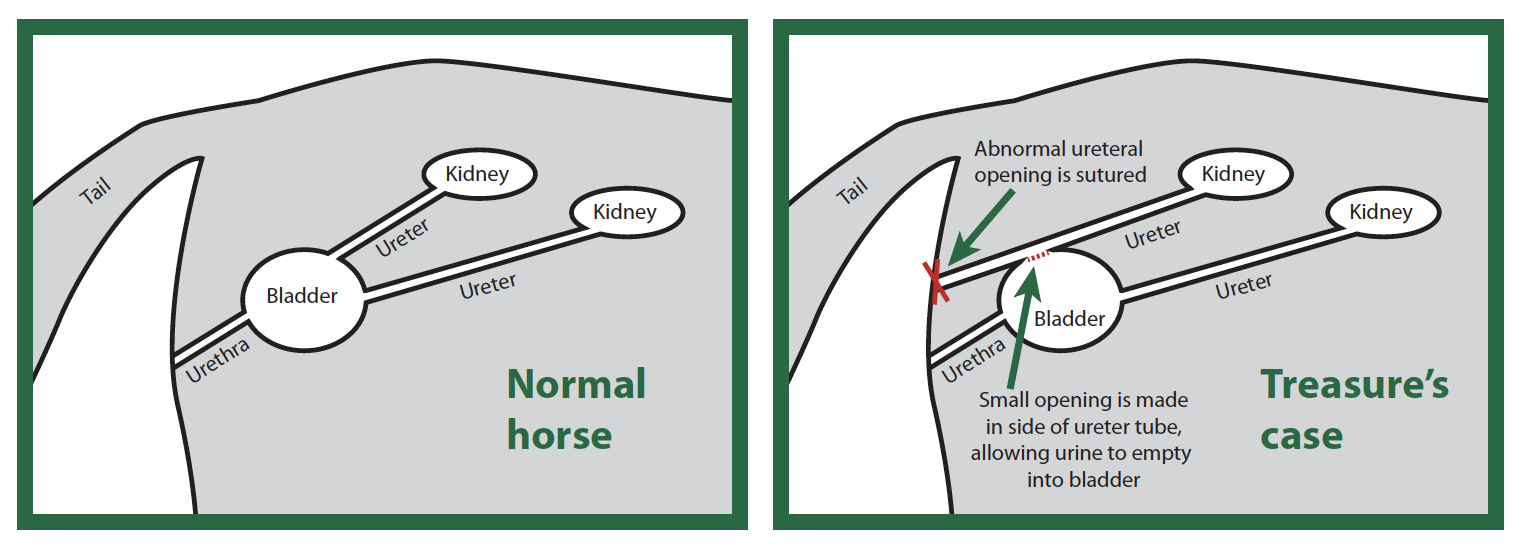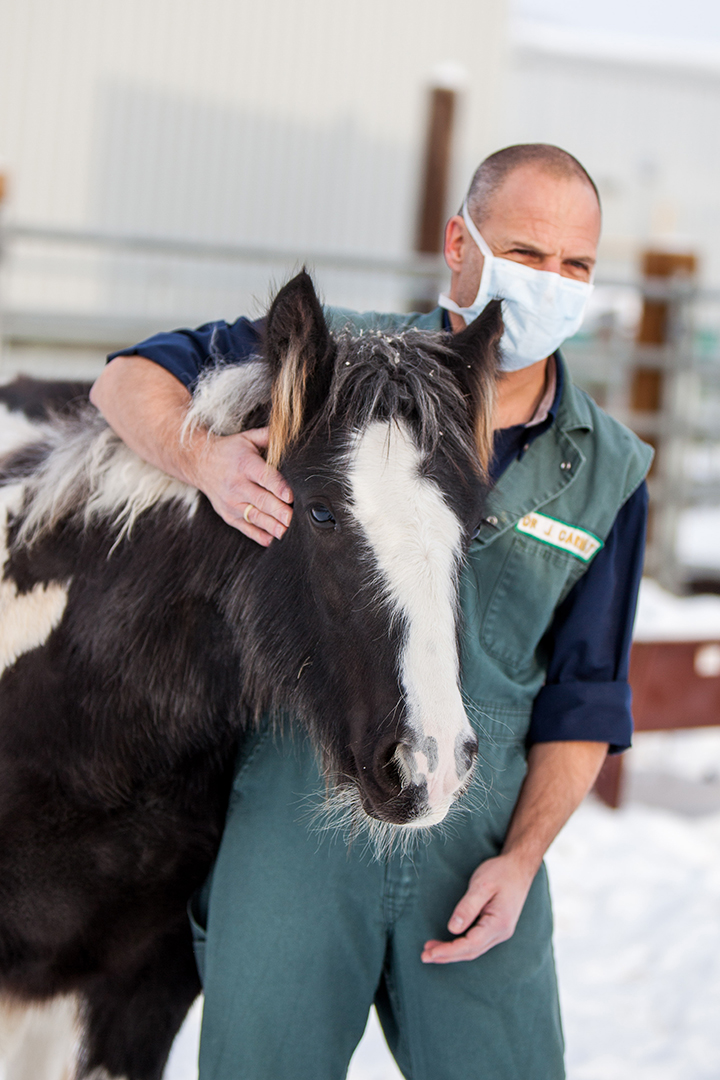
Lucky Treasure
Bright-eyed and well developed, Treasure appeared to be a perfectly healthy foal except for one critical flaw: the black and white Gypsy Vanner filly had a steady dribble of urine running down her hind legs.
By Lynne GunvilleThat telltale trickle, along with significant urine scalding of the skin below her vagina, definitely put a stain on the filly’s future. Incontinence is expected in older, experienced mothers, but no one was prepared to deal with this messy problem in such a young horse — especially during -30 C winters on the Prairies.
By October 2020, Treasure was being advertised online, potentially destined for the equine feedlot. That’s when the five-month-old filly’s luck changed. Among the users who saw Treasure’s ad on social media was Cindy Thomas of Evansburg, Alta., along with several other horse owners representing Horse Heroes Alberta. The not-for-profit rehoming network’s mandate is to help horses in need, and in Thomas’ eyes, Treasure’s situation aptly fit the description.
“She was just down on her luck, and we couldn’t let her go,” says Thomas, who helped make the sale and brought the filly back to the farm that she and her husband operate west of Edmonton.
While the filly settled in, Thomas began calling local veterinary clinics to see if anyone could help treat Treasure’s issue — one that’s often seen in dogs but rarely in horses. Treasure’s lucky streak continued when Thomas expanded her search to Saskatchewan and called Dr. James Carmalt, a professor and equine surgical specialist at the Western College of Veterinary Medicine’s Veterinary Medical Centre (VMC).
“As soon as I talked to Dr. Carmalt, he was so eager to help,” says Thomas. “He basically confirmed that it was an issue with her ureter, and he just said, ‘Let’s bring her in and let me see.’”

Misdirected tube
After Thomas hauled the filly to Saskatoon in late October, Carmalt verified that Treasure had an ectopic ureter, a congenital abnormality in one of the tubes that normally take urine from the kidney into the bladder. This misdirected tube was bypassing the bladder and dropping the urine into the birth canal, resulting in a constant dribble of urine out of the filly’s vagina.
Carmalt knew of two options for resolving the problem: he could remove the entire kidney, or he could try reconnecting the abnormal ureter to the bladder. The first option would eliminate the source of urine flowing to the abnormal ureter, but as Carmalt points out, a kidney removal is a substantial procedure in a horse. While the second option was much less invasive, there was no real guarantee that it would work.
With Thomas’ support, Carmalt began researching the second option, a surgical procedure that would use a laser to create a stoma or artificial opening in the side of the abnormal ureter tube that was enveloped in the wall of Treasure’s bladder. This opening would allow the urine to empty into the bladder rather than bypassing it and flowing into the filly’s birth canal.
“It’s really been a huge, combined effort — in-house, nationally and internationally. There’s a massive amount of learning and collaboration, talking to people about how best to manage her, trading ideas, and discussing options with other professional colleagues in Canada and around the world,” says Carmalt. “We were also very lucky that we had a client like Cindy who was willing to try these options.”
With Treasure sedated and positioned in the stocks, Carmalt, surgical resident Dr. Suzanne Mund and the clinical team carefully guided an endoscope into the filly’s ureter and used the laser’s energy to “burn” a small opening in the ureter’s side into the bladder, a process that required significant planning and precision. The end of the abnormal ureter was then sutured to block the flow of urine into the filly’s vagina.
“We had a ’scope in the bladder and a second one in the abnormal ureter. That way, we could turn the light off on the ’scope in the bladder and look for the light in the ureter,” explains Carmalt. “Then, we … just cut straight down from the narrow tube into the bigger bladder with the laser.”
A few days later the team performed a second procedure, using the laser once more to enlarge the initial hole until it was about one inch in size and less likely to close over.
‘Willing to give it a go’
Although the steady dribble of urine has stopped, Carmalt cautions that Treasure’s congenital abnormalities include a smaller bladder that’s positioned abnormally and may cause subsequent issues such as incontinence — a condition that can probably be managed with medication.
He points out that unique cases such as this one provide valuable learning experiences, particularly in a veterinary teaching hospital, and he’s grateful that Thomas and her rescue organization were willing to have him try a procedure that was far from a sure thing.

“I worked out the other day that we had about $200,000 worth of equipment beside this horse when we were working on her,” says Carmalt. “On top of that you’ve got to have a team that is willing to give it a go and potentially fail. And you need the right client — Cindy liked the idea that the team was thinking of the filly’s quality of life first.”
In addition to the surgeons (Carmalt along with Mund and surgical resident Dr. Antonio Guerra), others involved with Treasure’s treatment and care included theriogenologist Dr. Claire Card, anesthesia team members, registered veterinary technologists and attendants as well as several fourth-year veterinary students.
While the students benefited from the opportunity to witness and help treat a rare condition, they also learned the value of trying new things — an important career lesson whenever they’re challenged by a case or a procedure they haven’t done before.
“It’s an example of using everything around you — your colleagues, your tools, your brain, your comparative knowledge of other species — and pulling it all together for something that you haven’t seen before,” says Carmalt, who plans to write and submit a report about Treasure’s case to a peer-reviewed journal.
Since Treasure was considered a valuable teaching case, the VMC waived a portion of its total fee. It was an opportunity to generate good will and promote learning, but Carmalt also describes the case as a “practice builder,” helping to establish a good relationship with clients. That has certainly held true for Thomas and her organization who have brought several more cases to the VMC’s Large Animal Clinic for treatment.
Carmalt enjoys taking on challenging cases, largely because they push him to keep learning and to stay open to new ideas.
“From a teaching standpoint, it shows the students that you are never too far along in your career to benefit from the help or guidance of other people — and that it’s okay to ask for help,” says Carmalt.
“It also shows them that the only time you truly fail is when you don’t try. As long as you keep the welfare of the animal paramount and the client understands that you have never done this before, you might ultimately lose — which is going to suck horribly — but at least you tried.”
Thomas greatly appreciates the work that the WCVM team put into Treasure’s care and treatment, and she particularly likes the idea that students were able to learn from the filly’s case. The VMC team kept Treasure around for a few weeks last fall after the procedure so they could monitor her recovery, but she’s now back home and enjoying life.
“She will stay here on our farm,” says Thomas. “We’ll train her to be a little trail buddy, and she’ll be our organization’s ‘spokesperson’ — she’s proof that you shouldn’t give up on them so easily.”
Horse Heroes Alberta (HHA) is a not-for-profit network of people across Western Canada working together to help horses in need. Since 2018, HHA has found new homes for over 500 horses, donkeys and mules. Visit horseheroesalberta.com for details.
Read more equine health stories in the Spring 2021 issue of Horse Health Lines, publication for the Townsend Equine Health Research Fund.
